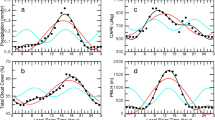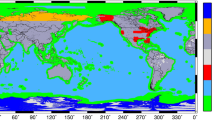Abstract
Turbulence characteristics of an atmospheric surface layer over a coastal mountain area were investigated under different coordinate frames. Performances of three methods of coordinate rotation: double rotation (DR), triple rotation (TR), and classic planar-fit rotation (PF) were examined in terms of correction of eddy covariance flux. Using the commonly used DR and TR methods, unreasonable rotation angles are encountered at low wind speeds and cause significant run-to-run errors of some turbulence characteristics. The PF method rotates the coordinate system to an ensemble-averaged plane, and shows large tilt error due to an inaccurate fit plane over variable terrain slopes. In this paper, we propose another coordinate rotation scheme. The observational data were separated into two groups according to wind direction. The PF method was adapted to find an ensemble-averaged streamline plane for each group of hourly runs with wind speed exceeding 1.0 m s−1. Then, the coordinate systems were rotated to their respective best-fit planes for all available hourly observations. We call this the PF10 method. The implications of tilt corrections for the turbulence characteristics are discussed with a focus on integral turbulence characteristics, the spectra of wind-velocity components, and sensible heat and momentum fluxes under various atmospheric stabilities. Our results show that the adapted application of PF provides greatly improved estimates of integral turbulence characteristics in complex terrain and maintains data quality. The comparisons of the sensible heat fluxes for four coordinate rotation methods to fluxes before correction indicate that the PF10 scheme is the best to preserve consistency between fluxes.
Similar content being viewed by others
References
Acevedo, O. C., and L. Mahrt, 2010: Systematic vertical variation of mesoscale fluxes in the nocturnal boundary layer. Bound.-Layer Meteor., 135, 19–30, doi: 10.1007/s10546-010-9465-4.
Baldocchi, D. D., and T. P. Meyers, 1988: Turbulence structure in a deciduous forest. Bound.-Layer Meteor., 43, 345–364.
Baldocchi, D., J. Finnigan, K. Wilson, U. K. T. Paw, and E. Falge, 2000: On measuring net ecosystem carbon exchange over tall vegetation on complex terrain. Bound.-Layer Meteor., 96, 257–291.
Berger, B. W., K. J. Davis, C. Yi, P. S. Bakwin, and C. L. Zhao, 2001: Long-term carbon dioxide fluxes from a very tall tower in a northern forest: Flux measurement methodology. J. Atmos. Oceanic Technol., 18, 529–542.
Dellwik, E., J. Mann, F. Bingöl, and K. Larsen, 2009: Mean vertical velocities and low tilt angles at a fetchlimited forest site in the context of carbon dioxide vertical advection. Biogeosciences Discussions, 6, 8167–8213.
Dyer, A. J., 1981: Flow distortion by supporting structure. Bound.-Layer Meteor., 20, 243–251.
Feigenwinter, C., and Coauthors, 2008: Comparison of horizontal and vertical advective CO2 fluxes at three forest sites. Agricultural and Forest Meteorology, 148, 12–24.
Finnigan, J. J., 2004: A re-evaluation of long-term flux measurement techniques. Part II: Coordinate systems. Bound.-Layer Meteor., 113, 1–41.
Finnigan, J. J., R. Clement, Y. Malhi, R. Leuning, and H. A. Cleugh, 2003: A re-evaluation of long-term flux measurement techniques. Part I: Averaging and coordinate rotation. Bound.-Layer Meteor., 107, 1–48.
Foken, T., and B. Wichura, 1996: Tools for the quality assessment of surface-based flux easurements. Agricultural and Forest Meteorology, 78, 83–105.
Foken, T., M. Göckede, M. Mauder, L. Mahrt, B. Amiro, and W. Munger, 2004: Post-field data quality control. Handbook of Micrometeorology: A Guide for Surface Flux Measurement and Analysis, Lee et al., Eds., Kluwer, Dordrecht, 181–208.
Gash, J. H., and A. D. Culf, 1996: Applying a linear detrend to eddy correlation data in real time. Bound.-Layer Meteor., 73, 301–306.
Göckede, M., C. Rebmann, and T. Foken, 2004: A combination of quality assessment tools for eddy covariance measurements with footprint modeling for the characterisation of complex sites. Agricultural and Forest Meteorology, 127, 175–188.
Hammerle, A., A. Haslwanter, M. Schmitt, M. Bahn, U. Tappeiner, A. Cernusca, and G. Wohlfahet, 2007: Eddy covariance measurements of carbon dioxide, latent and sensible energy fluxes above a meadow on a mountain slope. Bound.-Layer Meteor., 122, 397–416.
Kaimal, J. C., and D. A. Haugen, 1969: Some errors in the measurement of Reynolds stress. J. Appl. Meteor., 8, 460–462.
Kaimal, J. C., and J. J. Finnigan, 1994: Atmospheric Boundary Layer Flows: Their Structure and Measurement. Oxford University Press, New York, 289pp.
Kaimal, J. C., J. C. Wyngaard, Y. Izumi, and O. R. Cote, 1972: Spectral characteristics of surface layer turbulence. Quart. J. Roy. Meteor. Soc., 98, 563–589.
Kaimal, J. C., R. A. Eversole, D. H. Lenschow, B. B. Stankov, P. H. Kahn, and J. A. Businger, 1982: Spectral characteristics of the convective boundary-layer over uneven terrain. J. Atmos. Sci., 39, 1098–1114.
Kutsch, W., O. Kolle, C. Rebmann, A. Knohl, W. Ziegler, and E.-D. Schulze, 2008: Advection and resulting CO2exchange uncertainty in a tall forest in central Germany. Ecological Applications, 18, 1391–1405.
Lee, X., 1998: On micrometeorological observations of surface-air exchange over tall vegetation. Agricultural and Forest Meteorology, 91, 39–49.
Lee, X., and X. Hu, 2002: Forest-air fluxes of carbon, water and energy over non-flat terrain. Bound.-Layer Meteor., 103, 277–301.
Lee, X., J. Finnigan, and U. K. T. Paw, 2004: Coordinate systems and flux bias error. Handbook of Micrometeorology: A Guide for Surface Flux Measurement and Analysis, Lee et al., Eds., Kluwer, Dordrecht, 33–66.
Leuning, R., E. van Gorsel, W. J. Massman, and P. R. Isaac, 2012: Reflections on the surface energy imbalance problem. Agricultural and Forest Meteorology, 156, 65–74.
Massman, W. J., and X. Lee, 2002: Eddy covariance flux corrections and uncertainties in long-term studies of carbon and energy exchanges. Agricultural and Forest Meteorology, 113, 121–144.
McMillen, R. T., 1988: An eddy correlation technique with extended applicability to non-simple terrain. Bound.-Layer Meteor., 43, 231–245.
Paw, U. K. T., D. D. Baldocchi, T. P. Meyers, and K. B. Wilson, 2000: Correction of eddy-covariance measurements incorporating both advective effects and density fluxes. Bound.-Layer Meteor., 97, 487–511.
Schmid, H. P., H.-B. Su, C. S. Vogel, and P. S. Curtis, 2003: Ecosystem-atmosphere exchange of carbon dioxide over a mixed hardwood forest in northern lower Michigan. J. Geophys. Res., 108(D14), 4417–4435, doi: 10.1029/2002JD003011.
Spank, U., and C. Bernhofer, 2008: Another simple method of spectral correction to obtain robust eddycovariance results. Bound.-Layer Meteor., 128, 403–422.
Su, H.-B., H. P. Schmid, C. S. B. Grimmond, C. S. Vogel, and P. S. Curtis, 2008: An assessment of observed vertical flux divergence in long-term eddycovariance measurements over two Midwestern forest ecosystems. Agricultural and Forest Meteorology, 148, 186–205.
Sun, J., 2007: Tilt corrections over complex terrain and their implication for CO2 transport. Bound.-Layer Meteor., 124, 143–159.
Tanner, C. B., and G. W. Thurtell, 1969: Anemoclinometer measurements of Reynolds stress and heat transport in the atmospheric surface layer. ECOM 66-G22-F, University of Wisconsin, Madison, Wisconsin, 61–72.
Turnipseed, A. A., D. E. Anderson, P. D. Blanken, W. M. Baugh, and R. K. Monson, 2003: Airflows and turbulent flux measurements in mountainous terrain. Part I. Canopy and local effects. Agricultural and Forest Meteorology, 119, 1–21.
Vickers, D., and L. Mahrt, 1997: Quality control and flux sampling problems for tower and aircraft data. J. Atmos. Oceanic Technol. 14, 512–526.
van Dijk, A., A. F. Moene, and H. A. R. De Bruin, 2004: The principles of surface flux physics: Theory, practice and description of the ECPACK library. Internal Report 2004/1, Meteorology and Air Quality Group, Wageningen University, Wageningen, the Netherlands, 99pp.
Wyngaard, J. C., and O. R. Cote, 1971: The budgets of turbulent kinetic energy and temperature variance in the atmospheric surface layer. J. Atmos. Sci., 28, 190–201.
Wilczak, J. M., S. P. Oncley, and S. A. Sage, 2001: Sonic anemometer tilt correction algorithms. Bound.-Layer Meteor., 99, 127–150.
Yi, C., D. Anderson, A. Turnipseed, S. Burns, J. Sparks, D. Stannard, and R. Monsoon, 2008: The contribution of advective fluxes to net ecosystem exchange in a high-elevation, subalpine forest. Ecological Applications, 18, 1379–1390.
Yuan, R., M. Kang, S. B. Park, J. Hong, D. Lee, and J. Kim, 2011: Expansion of the planar-fit method to estimate flux over complex terrain. Meteor0. Atmos. Phys., 110, 123–133, doi: 10.1007/s00703-010-0113-9.
Zhang, H., J. Chen, and S. Park, 2001: Turbulence structure in unstable conditions over various surfaces. Bound.-Layer Meteor., 100, 243–261.
Zhang, Y., Z. Tan, Q. Song, G. Yu, and X. Sun, 2010: Respiration controls the unexpected seasonal pattern of carbon flux in an Asian tropical rain forest. Atmos. Environ., 44, 3886–3893
Zuo, J. Q., J. P. Huang, J. M. Wang, W. Zhang, J. R. Bi, G. Y. Wang, W. J. Li, and P. J. Fu, 2009: Surface turbulent flux measurements over the Loess Plateau for a semi-arid climate change study. Adv. Atmos. Sci., 26(4), 679–691, doi: 10.1007/s00376-009-8188-2.
Author information
Authors and Affiliations
Corresponding author
Rights and permissions
About this article
Cite this article
Liu, L., Wang, T., Sun, Z. et al. Eddy covariance tilt corrections over a coastal mountain area in South-east China: Significance for near-surface turbulence characteristics. Adv. Atmos. Sci. 29, 1264–1278 (2012). https://doi.org/10.1007/s00376-012-1052-9
Received:
Revised:
Published:
Issue Date:
DOI: https://doi.org/10.1007/s00376-012-1052-9




